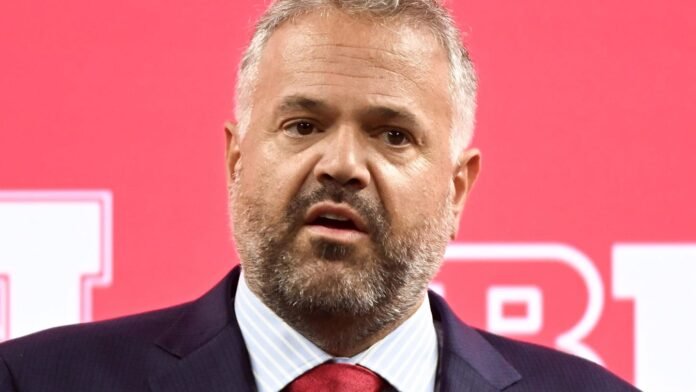When talking about Nebraska’s re-emergence into college football relevancy, Indiana is seen as the modern model of excellence.
For the Hoosiers, it basically was a one-season blast-off. From 3-9 in 2023, to 11-2 in 2024 — albeit against what turned out to be a weak schedule — Indiana was the undefeated darling of college football before being hammered at Ohio State, 38-15, on Nov. 23.
For those who thought Indiana would fold in the College Football Playoff, they were wrong. The Hoosiers went into the CFP as the 10 seed and gave in-state opponent Notre Dame all it could handle before losing, 27-17. Of course, Notre Dame advanced to the championship game before losing to Ohio State.
In defeat, the Hoosiers showed they belonged.
As Nebraska looks longingly at the Hoosiers’ 2024 success, the Huskers must wonder: Why not us? If Indiana, of all places, can become a national force in football, of all sports, surely the Huskers can, too.
The trick for Indiana now is this: Will it become a one-year wonder? Or, can enthusiastic second-year coach Curt Cignetti build a sustained program, one that can be a factor, if not every year, most years in the Big Ten?
The Huskers, 7-6 last season, have important pieces in place for success:
* Experienced quarterback in Dylan Raiola
* Well-regarded offensive coordinator in Dana Holgorsen
* Improving roster
* Solid lines
* Some important transfers
* Football tradition and culture
* Coach with a track record of winning
* Favorable schedule considered by some as the easiest in the Big Ten.
What lessons can be learned, what information can be gleaned from Indiana’s shocking season that was mostly fueled by the transfer portal?
First, Huskers coach Matt Rhule is looking to build a program, not necessarily a flashy, one-season supernova. In a heartbeat, Nebraska would take a huge single season — who wouldn’t? — but the plan is to be good every season.
I don’t think Rhule wants to rely more on the transfer portal than his own recruiting network. He wants a solid roster in place that is enhanced by transfers, not dictated by them.
If Nebraska were to have a huge single season, would that momentum continue? Would one great season transition into two or three such seasons? More important, would one great season open the floodgates on incoming, quality transfers, who might see and sense something special happening in Lincoln?
Would Nebraska’s recruiting parameters expand? Would more high school kids take a harder look at the Huskers? Would there be more official visits with serious intentions? Would there be more signatures on national letters of intent?
All possible. No guarantees, but that’s what a great season, or two, can do. Kids look at your program differently.
Cignetti, who enjoyed success at James Madison University, came into Bloomington in 2024. He soon had 31 transfers, including his quarterback, Kurtis Roarke, who arrived from Ohio University.
For a program that had won two Big Ten championships since joining the conference in 1953, it was a successful strategy and probably a necessary one.
Between 1994 and 2023, Indiana had two seasons of more than six wins. In that same timeframe, IU had three winning seasons and one was the Covid year.
The portal changed everything for IU last season. Until further notice, the portal is as much of college football as the marching band. Everyone does it, with varying degrees of success.
Nebraska’s approach is to take what it can get from the portal, hope to cut losses on outbound transfers, but continue to build the roster the old-fashioned way — targeted recruiting, development and retention.
The college football world might learn more about Indiana and its place in that world in 2025 than it did in 2024. And if Nebraska has a successful 2025 season, the book on the Huskers will be open, too.
Stay up to date on all things Huskers by bookmarking Nebraska Cornhuskers On SI, subscribing to HuskerMax on YouTube, and visiting HuskerMax.com daily.
